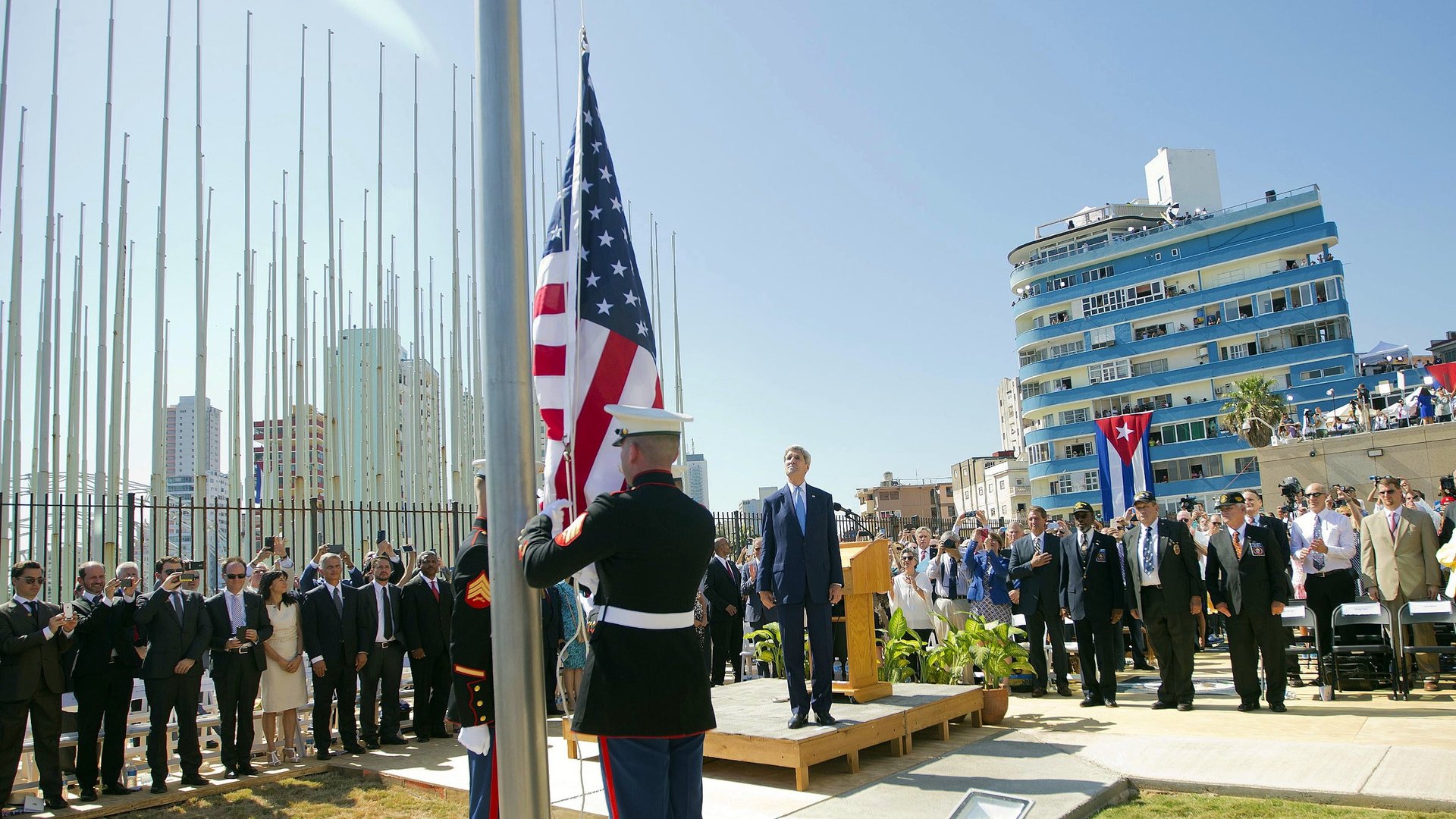The new American embassy in Cuba faces a familiar dilemma: Profits or politics?
With the US flag flying over an embassy in Cuba for the first time since 1960, American diplomats are back on the ground. And they face a conundrum that troubles their colleagues in countries from China to Russia: How to balance US commercial gains with idealistic foreign-policy goals?


With the US flag flying over an embassy in Cuba for the first time since 1960, American diplomats are back on the ground. And they face a conundrum that troubles their colleagues in countries from China to Russia: How to balance US commercial gains with idealistic foreign-policy goals?
Today’s schedule for secretary of state John Kerry, the first to visit Cuba since 1945, exemplifies this very dilemma. With officials, businesspeople and non-profit representatives in tow, he officially marked the return of diplomatic relations between the estranged countries at an embassy ceremony with Cuban officials (picture above). Afterwards, he planned to slip off to meet Cuban dissidents at the ambassador’s residence.
The push for the US to normalize relations with Cuba wasn’t primarily political. The Obama administration recognized that 50 years of embargo had done little to shake the grasp of the Castro government; but it was US businesses, keen to make money in a market they’d been locked out of, that were the driving force.
That has given rise to criticism that the US is conceding too much to the Cuban government, which, despite freeing 53 political prisoners as part of the initial agreement, has not hesitated to crack down on outspoken dissidents since then. But it is hard to give these complaints real moral force. The US maintains close economic and diplomatic relationships with many other regimes listed as “not free” in 2014 by the group Freedom House: Most obviously China, but also places like Saudi Arabia, Vietnam, Uzbekistan, Turkmenistan, Egypt, Qatar and Ethiopia.
This tension between political ideals and economic goals is at the heart of US history. It’s been a long road from the admonition of George Washington, the first US president, “steer clear of permanent alliances” with foreign nations (“cultivate peace and harmony with all,” he said) to the growth of a commercial empire underpinned by those same alliances. There’s no coincidence between the embrace of certain unfree regimes and their oil reserves.
This has sat uncomfortably next to the US’s rhetoric about democracy and human rights. And its many experiments with forcible regime change have hardly worked out well for the US, nor for the countries where they took place—which is no doubt why Kerry tried to sound reassuring by emphasizing that “Cuba’s future is for Cubans to shape.”
As China shows, hopes that economic reform will lead to political liberalization aren’t always borne out (though to be fair, that experiment has been going on for barely a generation). The Obama administration believes, not unreasonably, that Cuba is different from China—it’s far smaller and closer to the US, after all—and that efforts to get money into the nascent private sector and connect Cubans to Americans and their ideas will help hasten the inevitable transition away from a Castro led-government. Yet Cuba’s government sees this same process as a way to preserve its socialist model for longer.
For now, in Havana, US diplomats will have to balance their roles as promoters of business—helping major US corporations strike joint ventures with the Cuban government—and as promoters of ideals, meeting dissidents and promising them that, in Kerry’s words, ”the US will always remain a champion of democratic principles and reform.”
Kerry, a veteran of the US war in Vietnam, mentioned that he had recently celebrated the 20-year anniversary of normal relations with that country. In those two decades, Vietnam’s standard of living increased as it tied into the global economy, and now the US’s former Cold-War foe is negotiating a free-trade pact with it. Yet while it may no longer raise the hackles of US hawks, Vietnam is still considered a human-rights violator by global NGOs.
Still, a recent poll for the Washington Post found that more Cubans report being dissatisfied with their economic system than with their political system. So perhaps it makes sense for meddling Americans to start at the bottom and work their way up.